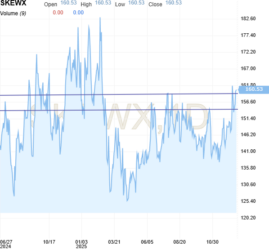Uddrag fra Merril Lynch:
It’s hard to recall a time when equity-market strategists were as divided as they are now over whether the stock market rally since mid-June is a bear-market rally or the beginning of a new bull market. While there are technical and fundamental analysts on both sides of this debate, the evidence to justify their views is more clearly divided, with technical signals more likely to favor the bull camp and fundamental trends supporting the bear camp.
In our experience, technical indicators often do a better job of forecasting market moves than the vast majority of economic analysts. This is because technical analysts let actual market developments, including relative price performance, guide their analysis, rather than faulty
macroeconomic forecasts. By assimilating the message in price action, technical indicators reflect the collective wisdom of the investment crowd, with the “smart money” leading the way. This collective wisdom tends to be better at identifying economic trends and turning points compared to consensus economic forecasts.
Basically, while it is fundamentals that ultimately shape economic and market outcomes, economic forecasters have a poor track record of anticipating economic developments, with this year’s massive inflation forecast error by the Federal Reserve (Fed) and consensus economists a glaring example. Technical indicators tend to be more timely to confirm the accuracy of various competing economic views, so they usually are consistent with the economic view suggested by sound fundamental analysis.
That said, this summer’s rally retracing 50% of the 2022 bear market is an exception, in our view. Technical rules based on historical experience have caused many strategists to declare the bear market over and the beginning of a new bull market. Indeed, 50% retracements of S&P 500 bear markets have been associated with new cyclical bull markets, as the S&P 500 Index retested its prior lows in a couple of instances but never made a lower low after a 50% retracement. This view has been strengthened by various momentum and breadth indicators which have also worked well throughout the past 75 years, with one caveat. This reliable track record does not apply as well to some other indexes, such as the NASDAQ.
The problem with this purely technical viewpoint currently is that this time there seems to be little fundamental basis for it. As Piper Sandler Companies observes, “All of these (prior) 50% retracements and subsequent New bull markets, were accompanied with an imminent and Major Economic Recovery in Leading Economic Indicators (Purchasing Managers’ Index, National Association of Home Builders, Housing Starts).” Clearly, that’s not the case now. The above-cited indicators along with a number of other leading indicators of economic activity have been falling this year, not rising.
For example, the Conference Board’s Leading Economic Index (LEI) indicators has fallen sharply for five straight months, suggesting additional weakening of industrial production and consumer spending ahead. In fact, a drop as large as that of the past five months has never happened without an ensuing recession. On a year-over-year (YoY) basis, the LEI has already hit the zero growth line and looks poised to drop into negative territory in the next few months, consistent with a subsequent recession.
In addition, according to Fed’s Survey of Senior Bank Loan Officers, lending standards tightened sharply in Q3, suggesting that following the quick and large negative effect on the housing market from the surge in mortgage rates, business investment will also come under pressure as commercial and industrial credit becomes much less abundant than it was over the past year and a half. This suggests that it’s
too early for a renewed cyclical bull market driven by fundamentals.
Indeed, the S&P 500 has never bottomed before a recession started. The view that this is a new cyclical bull market hinges on the soft landing viewpoint that assumes a recession is avoided and economic growth accelerates in 2023. That view, in turn, is based on a premature Fed pivot, which Fed Chair Powell dispelled thoroughly in his recent Fed Jackson Hole Summit comments. A new Equity bull market has never started in a tightening liquidity environment.
The big selloff after Mr. Powell’s hawkish comments suggests the new bull-market camp was front-running a pivot that is unlikely before a recession. Basically, this camp seems to be focused on wishful thinking about the end of monetary policy tightening. However, “don’t fight the Fed” is perhaps the most useful advice on Wall Street for a reason. With oil prices moderating and hopes of a Fed pivot, financial conditions such as credit spreads, interest-rate expectations and other stress indicators such as the Chicago Board Options
Exchange (CBOE) volatility index (VIX) loosened significantly during the summer rally in stocks.
However, the Fed is trying to tighten financial conditions. As Fed official after Fed official reiterated a hawkish message even before Chair Powell’s recent Jackson Hole speech, financial conditions began to tighten again. Still, the equity market wasn’t buying it even though the bond market re-priced for higher rates for a longer period. As a result, there was little reaction to Mr. Powell’s comments in the Fixed Income market, while the stock market had to begin the process of giving up its new bull market hopes. Mr. Powell basically put a nail in the coffin of the new equity bull market.
The rise in interest rates from their pivot-hope low point means stocks are overvalued again. The drop in the S&P 500 price/earnings (PE) ratio multiple from over 20 to about 15 in the first half of 2022 reflected the rise in interest rates by about 300 basis points from its extreme overvaluation driven by zero-rate liquidity abundance. Those Equity valuations are unlikely to return until zero rates and quantitative easing (QE) return. The 25% hit to P/Es coincided with the S&P 500 going from about 4,800 to about 3,600 with earnings relatively unchanged.
On the surface, earnings grew again in Q2, sparking bullish hopes. A look under the hood, however, reveals that Energy sector earnings are the only reason profits are up on a YoY basis. That’s why the Energy sector is the only global sector showing gains in 2022. As in other high inflation periods, the Energy and Materials stocks are expanding their share of the earnings pie.
As the earnings outlook deteriorates with more and more companies seeing reduced operating leverage, rising labor costs, weakening demand growth, and lower margins, a 15 P/E multiple may hold up if interest rates stabilize around current levels. Earnings, on the other hand, always fall in a recession usually by 20% to 40%. At 4,000 and a P/E multiple of 20, the S&P 500 would be discounting earnings of $200. A 15 multiple on the same earnings would imply 3,000 for the Index. So we would expect the S&P 500 to trade mainly in that range over the rest of the year consistent with the BofA Global Research targets for $200 of earnings in 2023 and a 3600
2022 year-end price level for the S&P 500.






